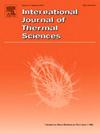球形凹窝管内紊流的热液特性
IF 5
2区 工程技术
Q1 ENGINEERING, MECHANICAL
International Journal of Thermal Sciences
Pub Date : 2025-05-29
DOI:10.1016/j.ijthermalsci.2025.110027
引用次数: 0
摘要
工程师们越来越多地在热系统中使用压窝管来提高性能,其中球形压窝管的影响最为显著。简单而准确的关联对于有效地评估新设计或改进的设备的性能至关重要。对球形酒窝进行了广泛的研究;然而,目前还没有研究全面考察酒窝直径、酒窝间距和酒窝星等几何参数的综合影响。本文采用数值模拟的方法研究了不同几何参数(包括凹窝间距、直径和星形)下球形凹窝管的水力和热性能。努塞尔数(Nu)、摩擦系数(fr)和性能评价标准(PEC)的新相关性作为这些参数和雷诺数的函数被开发出来。在恒热流密度为10kw /m2的条件下,对波纹管进行了分析。研究发现,增加凹窝间距会降低Nu、fr和PEC,偏差范围分别为3% ~ 40.5%、18.8% ~ 109.9%和- 4.2% ~ 12.6%。随着酒窝直径和恒星数量的增加,Nu和fr增大,但对PEC的影响不同。具体来说,随着酒窝直径的增加,Nu变化为13.1% ~ 89.3%,fr变化为51.9% ~ 509%,PEC变化在- 20.2% ~ 3.1%之间。当酒窝星的数量增加时,Nu的变化幅度为21.3% ~ 45%,fr从58.7%增加到277.9%,PEC的变化幅度为5.3% ~ 20%。结果还表明,基于韧窝参数和雷诺数,PEC数最大可达1.4。本文章由计算机程序翻译,如有差异,请以英文原文为准。
Hydrothermal performance of turbulent flow in tubes with spherical dimples
Engineers increasingly utilize dimpled tubes in thermal systems to enhance performance, with spherical dimples demonstrating the most significant impact. Simple and accurate correlations are essential for efficiently assessing the performance of newly designed or improved equipment. Extensive research has been conducted on spherical dimples; however, no study has comprehensively examined the combined effects of geometric parameters such as dimple diameter, dimple pitch, and dimple stars. This study uses numerical simulations to investigate the hydraulic and thermal performance of spherical dimpled tubes with varying geometric parameters, including dimple pitch, diameter, and the stars. New correlations for the Nusselt number (Nu), friction factor (fr), and performance evaluation criteria (PEC) are developed as functions of these parameters and the Reynolds number. The dimpled tube is analyzed under a constant heat flux of 10 kW/m2. The study finds that increasing dimple pitch decreases Nu, fr, and PEC, with deviations ranging from 3 % to 40.5 %, 18.8 %–109.9 %, and −4.2 % to 12.6 %, respectively. Increasing dimple diameter and the number of stars increases Nu and fr, but the effect on PEC varies. Specifically, as dimple diameter increases, Nu changes by 13.1 %–89.3 %, fr rises by 51.9 %–509 %, and PEC varies between −20.2 % and 3.1 %. When the number of dimple stars increases, Nu changes by 21.3 %–45 %, fr increases from 58.7 % to 277.9 %, and PEC improves by 5.3 %–20 %. The results also show that, based on the dimple parameters and Reynolds number, the PEC number can reach a maximum of 1.4.
求助全文
通过发布文献求助,成功后即可免费获取论文全文。
去求助
来源期刊

International Journal of Thermal Sciences
工程技术-工程:机械
CiteScore
8.10
自引率
11.10%
发文量
531
审稿时长
55 days
期刊介绍:
The International Journal of Thermal Sciences is a journal devoted to the publication of fundamental studies on the physics of transfer processes in general, with an emphasis on thermal aspects and also applied research on various processes, energy systems and the environment. Articles are published in English and French, and are subject to peer review.
The fundamental subjects considered within the scope of the journal are:
* Heat and relevant mass transfer at all scales (nano, micro and macro) and in all types of material (heterogeneous, composites, biological,...) and fluid flow
* Forced, natural or mixed convection in reactive or non-reactive media
* Single or multi–phase fluid flow with or without phase change
* Near–and far–field radiative heat transfer
* Combined modes of heat transfer in complex systems (for example, plasmas, biological, geological,...)
* Multiscale modelling
The applied research topics include:
* Heat exchangers, heat pipes, cooling processes
* Transport phenomena taking place in industrial processes (chemical, food and agricultural, metallurgical, space and aeronautical, automobile industries)
* Nano–and micro–technology for energy, space, biosystems and devices
* Heat transport analysis in advanced systems
* Impact of energy–related processes on environment, and emerging energy systems
The study of thermophysical properties of materials and fluids, thermal measurement techniques, inverse methods, and the developments of experimental methods are within the scope of the International Journal of Thermal Sciences which also covers the modelling, and numerical methods applied to thermal transfer.
 求助内容:
求助内容: 应助结果提醒方式:
应助结果提醒方式:


